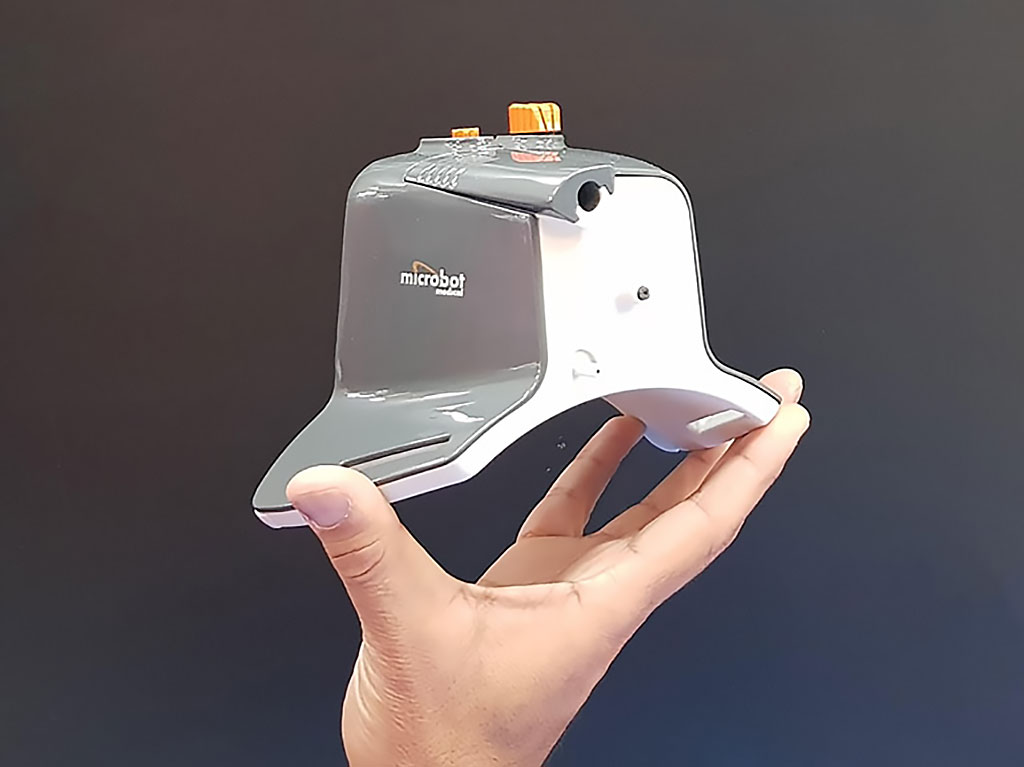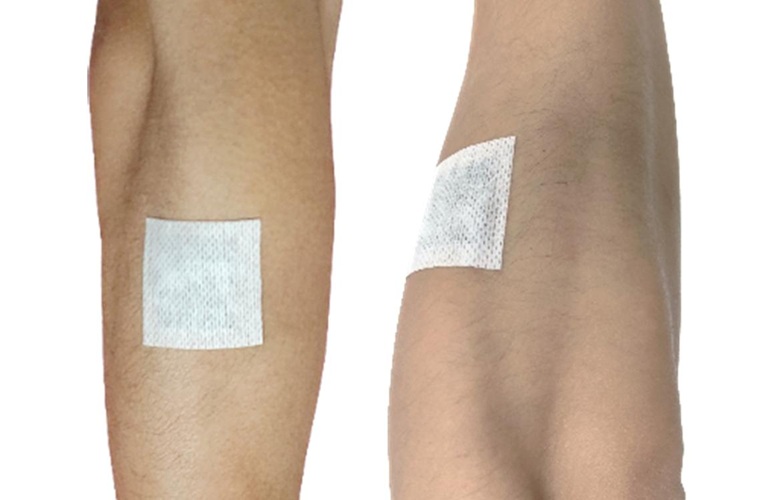Disposable Robotic System Advances Endovascular Procedures
|
By HospiMedica International staff writers Posted on 06 Feb 2020 |

Image: The Liberty robotic system (Photo courtesy of Microbot Medical)
A fully disposable robotic catheterization system reduces radiation exposure and physical strain to the attending physician.
The Microbot Medical (Yokneam, Israel) Liberty robotic system is a disposable mini-robot strapped to a patients arm that is intended for remote use during neurovascular, cardiovascular, and peripheral vascular procedures. Liberty combines a guidewire and a micro-catheter into a single “One & Done” device that allows linear and rotational motion, as well as tip rotation of the integrated device. An intuitive remote control that resembles a game controller simplifies advanced procedures while shortening the operator’s learning curve.
The system is also ready for tele-catheterization procedures by specialists, and can also provide linear motion for additional over-the-wire devices. Major financial benefits of the device are primarily in the reduction in consumables; and secondly, since it is disposable, there is no reprocessing and sterilization needed.
“Liberty is set to revolutionize the way surgical robotics are being used in endovascular procedures, by eliminating the need for capital equipment, reducing radiation exposure, and aiming to streamline the use of disposables during these complex procedures,” said Harel Gadot, CEO, president, and chairman of Microbot Medical. “With Liberty’s remote operation as well as its ‘One & Done’ capabilities, we believe it has the potential to be the first system to democratize endovascular interventional procedures by shortening the physician’s learning curve.”
“I believe Liberty will be welcomed by the interventional community due to its clinical and technical benefits in various subspecialties, such as neurovascular, cardiovascular, and peripheral vascular interventions,” said interventional radiologist Eyal Morag, MD, of Assuta Medical Center (Ashdod, Israel). “The system set up is easy and straightforward, and it offers intuitive remote operation capabilities designed to reduce radiation exposure and eliminate physical strain on the physicians.”
Related Links:
Microbot Medical
The Microbot Medical (Yokneam, Israel) Liberty robotic system is a disposable mini-robot strapped to a patients arm that is intended for remote use during neurovascular, cardiovascular, and peripheral vascular procedures. Liberty combines a guidewire and a micro-catheter into a single “One & Done” device that allows linear and rotational motion, as well as tip rotation of the integrated device. An intuitive remote control that resembles a game controller simplifies advanced procedures while shortening the operator’s learning curve.
The system is also ready for tele-catheterization procedures by specialists, and can also provide linear motion for additional over-the-wire devices. Major financial benefits of the device are primarily in the reduction in consumables; and secondly, since it is disposable, there is no reprocessing and sterilization needed.
“Liberty is set to revolutionize the way surgical robotics are being used in endovascular procedures, by eliminating the need for capital equipment, reducing radiation exposure, and aiming to streamline the use of disposables during these complex procedures,” said Harel Gadot, CEO, president, and chairman of Microbot Medical. “With Liberty’s remote operation as well as its ‘One & Done’ capabilities, we believe it has the potential to be the first system to democratize endovascular interventional procedures by shortening the physician’s learning curve.”
“I believe Liberty will be welcomed by the interventional community due to its clinical and technical benefits in various subspecialties, such as neurovascular, cardiovascular, and peripheral vascular interventions,” said interventional radiologist Eyal Morag, MD, of Assuta Medical Center (Ashdod, Israel). “The system set up is easy and straightforward, and it offers intuitive remote operation capabilities designed to reduce radiation exposure and eliminate physical strain on the physicians.”
Related Links:
Microbot Medical
Latest Surgical Techniques News
- Superior Orthopedic Implants Combat Infections and Quicken Healing After Surgery
- Laser-Based Technique Eliminates Pancreatic Tumors While Protecting Healthy Tissue
- Surgical Treatment of Severe Carotid Artery Stenosis Benefits Blood-Brain Barrier
- Revolutionary Reusable Duodenoscope Introduces 68-Minute Sterilization
- World's First Transcatheter Smart Implant Monitors and Treats Congestion in Heart Failure
- Hybrid Endoscope Marks Breakthrough in Surgical Visualization
- Robot-Assisted Bronchoscope Diagnoses Tiniest and Hardest to Reach Lung Tumors
- Diamond-Titanium Device Paves Way for Smart Implants that Warn of Disease Progression
- 3D Printable Bio-Active Glass Could Serve as Bone Replacement Material
- Spider-Inspired Magnetic Soft Robots to Perform Minimally Invasive GI Tract Procedures
- Micro Imaging Device Paired with Endoscope Spots Cancers at Earlier Stage
- AI Spine Model Could Reduce Surgical Risks
- Novel Method Uses Interstitial Fluid Flow to Predict Where Brain Tumor Can Grow Next
- World’s First Custom Anterior Cervical Spine Surgery Performed Using Personalized Implant
- Implantable Biodegradable Scaffold Helps Broken Bones Regrow Quickly
- First Human Spinal Cord Repair Using Patient Own Cells Could Cure Paralysis
Channels
Critical Care
view channel
Highly Sensitive On-Skin Sensing Monitor Detects Vitamin B6 and Glucose in Sweat
Vitamin B6 plays a crucial role in immune function and brain health, yet patients with chronic conditions such as diabetes often experience deficiencies that can cause irritability, depression, anemia,... Read more
Artificial Intelligence Revolutionizing Pediatric Anesthesia Management
Administering anesthesia to children poses unique challenges, as their anatomy varies significantly even among patients of the same age. Misjudging the correct breathing tube size or failing to detect... Read morePatient Care
view channel
Revolutionary Automatic IV-Line Flushing Device to Enhance Infusion Care
More than 80% of in-hospital patients receive intravenous (IV) therapy. Every dose of IV medicine delivered in a small volume (<250 mL) infusion bag should be followed by subsequent flushing to ensure... Read more
VR Training Tool Combats Contamination of Portable Medical Equipment
Healthcare-associated infections (HAIs) impact one in every 31 patients, cause nearly 100,000 deaths each year, and cost USD 28.4 billion in direct medical expenses. Notably, up to 75% of these infections... Read more
Portable Biosensor Platform to Reduce Hospital-Acquired Infections
Approximately 4 million patients in the European Union acquire healthcare-associated infections (HAIs) or nosocomial infections each year, with around 37,000 deaths directly resulting from these infections,... Read moreFirst-Of-Its-Kind Portable Germicidal Light Technology Disinfects High-Touch Clinical Surfaces in Seconds
Reducing healthcare-acquired infections (HAIs) remains a pressing issue within global healthcare systems. In the United States alone, 1.7 million patients contract HAIs annually, leading to approximately... Read moreHealth IT
view channel
Printable Molecule-Selective Nanoparticles Enable Mass Production of Wearable Biosensors
The future of medicine is likely to focus on the personalization of healthcare—understanding exactly what an individual requires and delivering the appropriate combination of nutrients, metabolites, and... Read moreBusiness
view channel
Philips and Masimo Partner to Advance Patient Monitoring Measurement Technologies
Royal Philips (Amsterdam, Netherlands) and Masimo (Irvine, California, USA) have renewed their multi-year strategic collaboration, combining Philips’ expertise in patient monitoring with Masimo’s noninvasive... Read more
B. Braun Acquires Digital Microsurgery Company True Digital Surgery
The high-end microsurgery market in neurosurgery, spine, and ENT is undergoing a significant transformation. Traditional analog microscopes are giving way to digital exoscopes, which provide improved visualization,... Read more
CMEF 2025 to Promote Holistic and High-Quality Development of Medical and Health Industry
The 92nd China International Medical Equipment Fair (CMEF 2025) Autumn Exhibition is scheduled to be held from September 26 to 29 at the China Import and Export Fair Complex (Canton Fair Complex) in Guangzhou.... Read more







.jpg)






